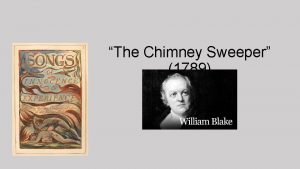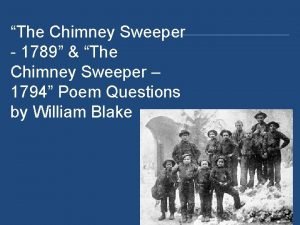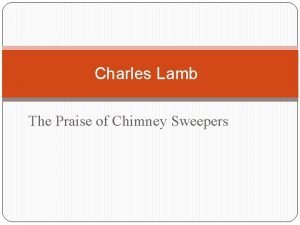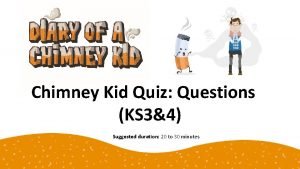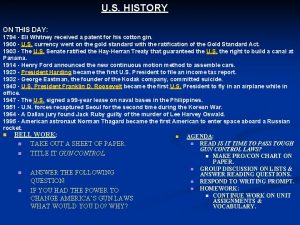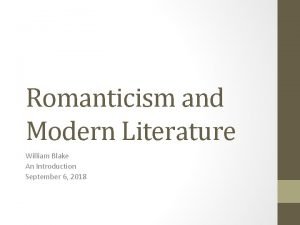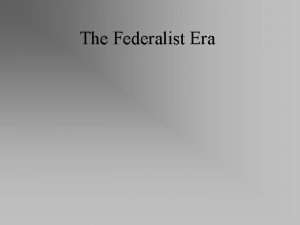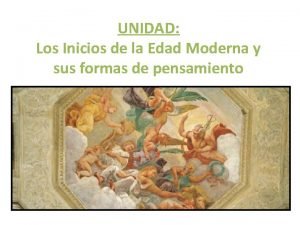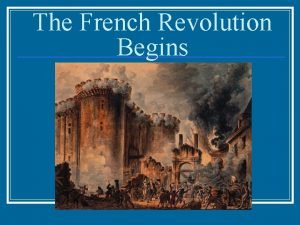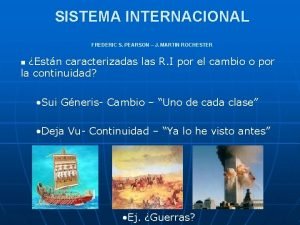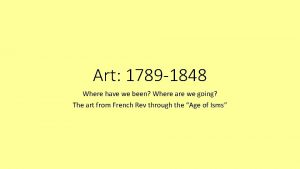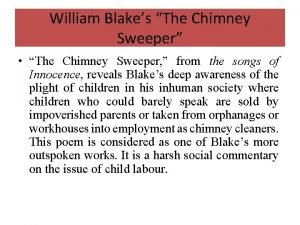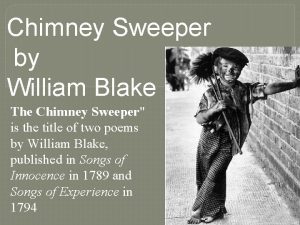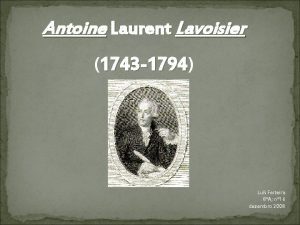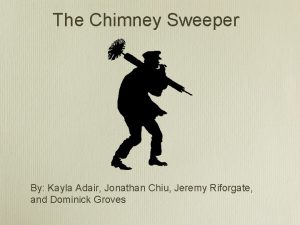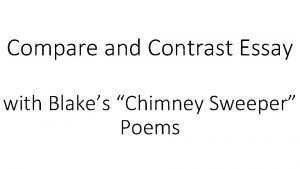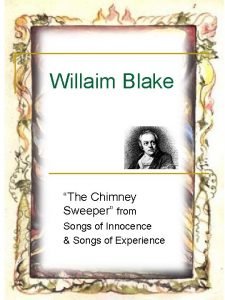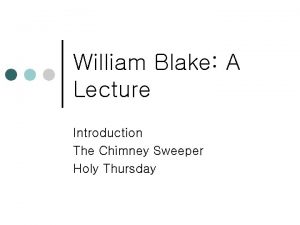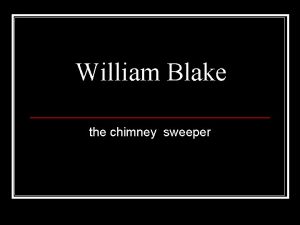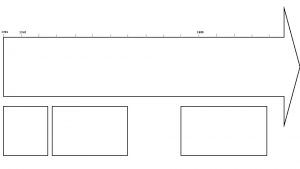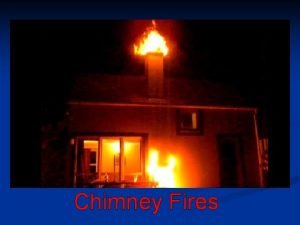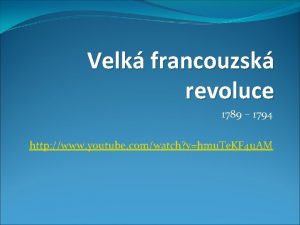The Chimney Sweeper 1789 The Chimney Sweeper 1794














- Slides: 14

“The Chimney Sweeper - 1789” & “The Chimney Sweeper – 1794” Poem Questions by William Blake

: ”The Chimney Sweeper – 1789”

Stanza One 1. Who is the speaker of the poem? 2. What happened to his father and mother? 3. How old was he? What is our clue about his age? 4. What is the effect of the repetition of the word, weep? 5. What is the child chimney sweep really trying to say? 6. Where is the setting of this poem?

Stanza Two 1. What is little Tom Dacre doing? Why? 2. How is hair described? 3. What are they doing to his hair? 4. What is this an allusion to? 5. What does the speaker say to comfort Tom?

Stanza Three 1. Did Tom stop crying? Evidence? 2. What does Tom dream about? Describe. 3. What is the double meaning for "coffins of black"? Describe both.

Stanza Four 1. What does the "Angel who had a bright key" allude to? 2. What does the Angel do? 3. What do the children do? 4. How is line three different from the daily life of a child chimney sweep? 5. What is the symbolic significance of washing in the river? 6. What is the double meaning of "shine in the Sun, " and why is Sun capitalized?

Stanza Five 1. What is happening is the first two lines of stanza five? Describe. 2. Why are the children chimney sweeps described as "naked and white"? 3. What is the significance of their bags being left behind? 4. According the to Angel, what is the reward for Tom if he is good? 5. In Tom's daily life as a chimney sweep, who may have given a message to Tom similar to what the Angel tells him? Why?

Stanza Six 1. What does Tom do when he wakes up in the morning? 2. What is Tom's consolation as he goes off to work? 3. Does the reader share the same confidence as Tom? How is this dramatic irony? 4. What is Blake's subtle critique of how religion is being used in the lives of the chimney sweeps by those in charge of them?

Final Summation Questions 1. What is the impact of developing the poem from the point of view of the young speaker and his observance of Tom Dacre? Is this effective? Why? 2. What is the message - theme of this poem? 3. How does Blake's structure, where he chooses to begin and to end the poem, contribute to his overall message? 4. Who is Blake speaking to - who is his intended audience? 5. What is the meter and rhyme of this poem similar to or remind the reader of? What is the irony of this? How does it contribute to theme? 6. How does the last stanza require the reader to distinguish the difference between what is directly stated in the text to what Blake really means as a form of sarcasm and irony?

“The Chimney Sweeper – 1794”

1. Who is the speaker in stanza one? 2. How is the chimney sweeper described in line one? 3. What is the child chimney sweep doing? 4. How does the word "crying" have a double meaning? 5. What does the speaker ask the child chimney sweep? 6. What is the child's response? 7. What are the possible explanations for the child's answer, based on what the reader knows of child chimney sweeps in the 1789 poem? Stanza One

1. Who is speaking in stanza two? 2. What is a heath? Describe. Stanza 3. What does it mean - that the child was "happy upon the heath"? 4. How could the image - "smil'd among the winter's snow" - have a double or deeper symbolic meaning? 5. What are the "clothes of death"? What else does this image refer to in a large context? 6. Where else are people singing in the poem? Describe the child chimney sweeper's song and compare and contrast. 7. How does the word, "notes, " refer to singing? Two

Stanza Three 1. How does line of reflect the nature of a child despite their circumstances? Describe. 2. Who is the word, "they, " a reference to in line two? 3. Why do "they" think they have caused "no injury"? 4. Where are they "praising" according to stanza one? 5. "God & his Priest and king" are symbolic references for who or what? 6. Explain the paradox - "heaven of our misery"? What is the heaven referred to? What is the misery?

Final Summation Questions 1. Why does Blake structure this poem differently, with the child chimney sweeper talking directly to an adult observer? 2. How is this child chimney sweep more experienced than Tom Dacre in the first poem? 3. What is the critique of eighteenth century English society presented through the child chimney sweeper's point of view? Therefore, what is theme? 4. How does the more experienced chimney sweeper in this poem compare and contrast to the innocence of Tom Dacre in the 1789 poem?
 Chimney sweeper songs of innocence and experience
Chimney sweeper songs of innocence and experience The chimney sweeper dramatic irony
The chimney sweeper dramatic irony Praise of chimney sweepers
Praise of chimney sweepers The chimney sweeper quiz
The chimney sweeper quiz 1794-1743
1794-1743 Introduction (blake, 1794)
Introduction (blake, 1794) 1794-1743
1794-1743 Marie curie
Marie curie Repelics
Repelics Adware sweeper
Adware sweeper Linea de tiempo con las edades de la historia
Linea de tiempo con las edades de la historia French revolution cartoons explained
French revolution cartoons explained 1797 - 1789
1797 - 1789 Sistema clasico internacional 1648 a 1789
Sistema clasico internacional 1648 a 1789 Art 1789
Art 1789
